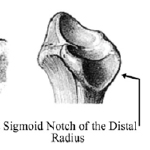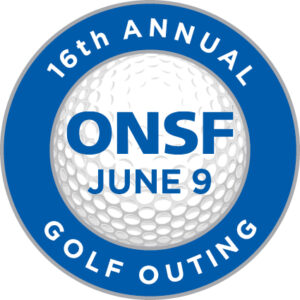Understanding the Risk of Arthritis after Wrist Fractures of the Distal Radioulnar Joint
 Joints are the specialized structures in the musculoskeletal system that connects two bones. Most joints are covered with specialized articular cartilage that provides a smooth, gliding surface allowing near frictionless motion and providing shock absorption at the joint. Arthritis is a condition in which a joint surface becomes damaged and the articular cartilage wears out, causing pain, stiffness and loss of motion. A body of research amassed over the last several decades has taught us that fractures disrupting the cartilage-bearing articular surface of various joints in the body may predispose patients to later post-traumatic arthritis in those joints, particularly if the fractured joint surface does not heal in a smooth, congruous position.
Joints are the specialized structures in the musculoskeletal system that connects two bones. Most joints are covered with specialized articular cartilage that provides a smooth, gliding surface allowing near frictionless motion and providing shock absorption at the joint. Arthritis is a condition in which a joint surface becomes damaged and the articular cartilage wears out, causing pain, stiffness and loss of motion. A body of research amassed over the last several decades has taught us that fractures disrupting the cartilage-bearing articular surface of various joints in the body may predispose patients to later post-traumatic arthritis in those joints, particularly if the fractured joint surface does not heal in a smooth, congruous position.
Dr. Mark Vitale, in a collaborative study with investigators and hand surgeons at the Mayo Clinic, sought to investigate fractures of one of the overlooked and understudied joints of the wrist called the Distal Radioulnar Joint (DRUJ). The purpose of this study was to determine whether patients with fractures of the wrist involving one of the cartilage surfaces of the DRUJ called the sigmoid notch would have a higher prevalence of arthritis of this joint compared to a matched control group of wrist fractures without involvement of this cartilage surface.
Bony anatomy of the DRUJ of the wrist. The sigmoid notch forms the articular surface of the distal radius of the DRUJ, a joint that allows for forearm rotation

Bony anatomy of the DRUJ of the wrist. The sigmoid notch forms the articular surface of the distal radius of the DRUJ, a joint that allows for forearm rotation.

X-ray showing arthritis of the Distal Radioulnar Joint (DRUJ) of the wrist as evidenced by joint space narrowing and bone spurs (highlighted in yellow circle).
The investigators examined 33 patients with wrist fractures that were severe enough to require surgery to realign the wrist bones. The precise position of healing of the cartilage surface of the sigmoid notch of the wrist was assessed with CT scans postoperatively to determine if patients with fractures healed in a displaced or maligned position would have a greater risk for later prevalence of arthritis of this joint and poorer upper extremity function.
At an average of more than 6 years after wrist fracture surgery, patients with fractures into the DRUJ had equivalent outcomes to those without fractures extending into this wrist joint. There was a very low incidence of DRUJ arthritis in all patients, indicating that the DRUJ may be a fairly tolerant joint for minor joint incongruity. The exception was patients with fractures that had a step-off of the cartilage surface of the joint by more than 1 millimeter in the coronal plane based on CT scan measurements, and this subset of patients had significantly worse upper extremity disability scores more than 6 years after sustaining their injuries.
Hand and Wrist specialists can treat arthritis of the wrist when it develops years after an injury, but ideally surgeons seek to identify the optimal conditions that can be influenced during the initial treatment of traumatic injuries of the joint surfaces to prevent arthritis from ever developing. This study suggests that attention should be paid to coronal plane congruity of the sigmoid notch of the DRUJ during the initial treatment of these fractures. The results are also promising in that they show that the DRUJ rarely becomes arthritic after wrist fractures. Further work is necessary to better identify the effect of DRUJ incongruity on patient outcomes and the development of post-traumatic arthritis.

Dr. Vitale discussing his research as a podium presentation at the ASSH in Boston, MA, Sept 2014.
Dr. Vitale presented this study, “Intra-articular Fractures of the Sigmoid Notch of the Distal Radius”, at the 69th annual American Society for Surgery of the Hand (ASSH) in Boston, MA. The ASSH recognized this study as the best wrist research paper of the meeting, and Dr. Vitale was chosen as the 2014 Ronald Linscheid-James Dobyns Excellence in Wrist Surgery honoree. The goal of this award is to honor the legacy of Drs. Linscheid and Dobyns, two pioneers of wrist surgery, by annually recognizing the best wrist research paper presented at the ASSH Annual meeting. As the primary author of the winning manuscript, Dr. Vitale has been invited to Chair the Lincheid-Dobyns Excellence in Wrist Research Instructional Course at the 70th ASSH Annual Meeting in Seattle, WA over September, 2015.







